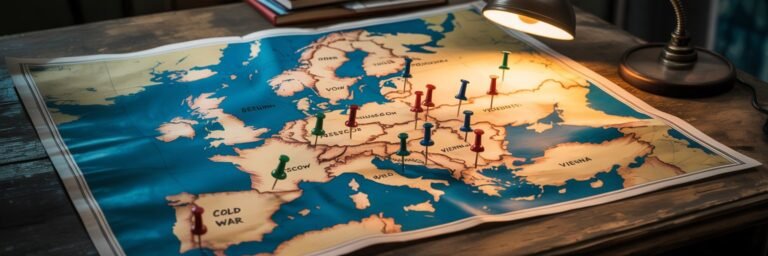INTRODUCTION
The Cold War, a period of East-West rivalry between the Soviet Union and the Western powers, notably the United States, following the end of the Second World War, is a well-tread topic for historians all over the world. It lasted for nearly half a century, from 1947 to 1991, a time teeming with espionage, myth, paranoia, ideological contest, and near existential crises. This period left an indelible imprint on global history, shaping the contemporary world order in ways still visible today. However, beyond the orthodox narrative of the Cold War, there lie stories untold, secrets unrevealed, and speculative theories unexplored. This article delves into these unseen corners of Cold War history, weaving a vivid tapestry of the epoch’s mysteries, controversies, and cultural significance.
HISTORICAL BACKGROUND
Since its inception, the Cold War was characterized by a tense stalemate between two superpowers, grounded in diametrically opposed ideologies: communism represented by the Soviet Union and liberal-democratic capitalism trumpeted by the United States. Following the devastation of World War II, these superpowers emerged as dominant global forces wielding almost symbiotic power – the triumph of one threatened the existence of the other.
Historians agree that one of the earliest harbingers of the Cold War was Winston Churchill’s Iron Curtain speech, delivered in Fulton, Missouri, on March 5, 1946. Speaking alongside President Harry Truman, Churchill described an “iron curtain” that had “descended across the Continent” of Europe. From this moment, the divide between the communist East and the capitalist West began to harden, setting the stage for the ideological cold war that followed.
THEORIES AND INTERPRETATIONS
Despite mainstream consensus on key events, alternative theories on the Cold War abound among scholars. The ‘orthodox’ interpretation, often called the “traditionalist” school, places blame for the Cold War largely on the Soviet Union’s shoulders. Historians like Arthur Schlesinger Jr. argue that Stalin’s aggressive expansionist policies led to U.S. responses that simply sought to contain communism.
Conversely, “revisionist” thinkers led by William Appleman Williams, comprehensively challenged this consensus in the 1960s and 70s. These theorists claimed that America’s vision of an “open door” economic policy led to an imperialistic drive for global hegemony, thereby triggering the Cold War.
More recently, the ‘post-revisionist’ school has emerged, under proponents like John Lewis Gaddis, urging a more nuanced understanding of the Cold War. They suggest both superpowers were seduced by exaggerated threat perceptions and thus engaged in an unending spiral of conflict-defensive responses.
MYSTERIES AND CONTROVERSIES
The epoch of the Cold War was shrouded in secrecy, producing an array of mysteries and controversies. The Cuban Missile Crisis of 1962, considered the most perilous episode of the era, left us puzzled: Why would Khrushchev risk the very existence of the Soviet Union by installing nuclear weapons 90 miles off the US coast? Revisionist historians assert that it was a calculated response to Kennedy’s adventurism on the global chessboard. Yet the question remains hotly debated.
Add to this the enigma of the spying agencies—the CIA, MI6, KGB: Holocaust hero Raoul Wallenberg’s mysterious disappearance in Budapest; the perplexing fate of Rudolf Abel, the USSR’s master spy; the scandalous Cambridge Spy Ring—all these serve only to add layers to an already mysterious era.
SYMBOLISM AND CULTURAL SIGNIFICANCE
The Cold War era was potent with symbolism and ripe with cultural significance. McCarthyism and the Red Scare are synonymous with fear-driven political persecution, while the Berlin Wall, erected in 1961, became the quintessential emblem of the Cold War—a physical metaphor for the Iron Curtain.
This era also witnessed technological leaps, epitomized by the Space Race, which spurred both superpowers to extraordinary achievements in science and exploration, as symbolized by Yuri Gagarin’s world-shaking orbit of Earth and Neil Armstrong’s monumental moonwalk.
Moreover, the Cold War had profound cultural implications. In literature and film emerged classics like “Doctor Strangelove,” “The Spy Who Came in from the Cold,” and “Nineteen Eighty-Four,” encapsulating the pervasive fear, paranoia, and existential dread of the era.
MODERN INVESTIGATIONS
Even thirty years after its conclusion, the Cold War continues to be a subject of intense academic interrogation. Scholars are still unearthing new facets, employing historical reinterpretation bolstered by declassified materials. Moreover, modern historiography, aided by the opening of archives in the former Soviet bloc countries, has broadened our understanding of the period, resulting in renewed interests in espionage history, the role of the satellite states, and the global impact of the Cold War.
LEGACY AND CONCLUSION
The Cold War’s legacy continues to linger unmistakably on everything from today’s geopolitics to pop culture, making it an incredibly relevant era of study. It gave rise to the age of nuclear deterrence, fundamentally shaping today’s global military strategy. It spurred decolonization and realignment around the world, giving birth to the non-aligned movement.
Furthermore, it left an ineradicable mark on popular culture. James Bond’s eternal fight against vague, shape-shifting enemies is a direct outcome of Cold War anxieties, as are the myriad spy thrillers that have saturated our screens over the years.
In conclusion, the Cold War’s veil of secrecy and underlying anxieties created a fertile ground for untold stories, multiple interpretations, and cultural significance that has transcended the passage of time. Through ongoing revisits and untiring discourse, it remains a vibrant, if a haunting part of our collective consciousness—a world historical event that deserves inexhaustible exploration.






